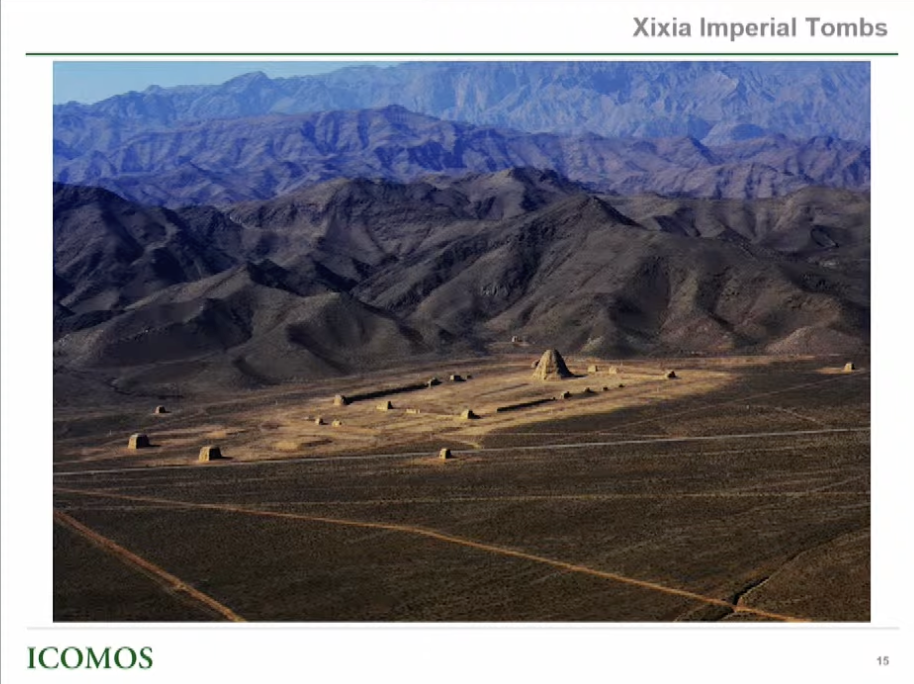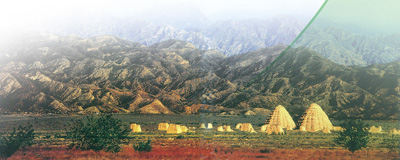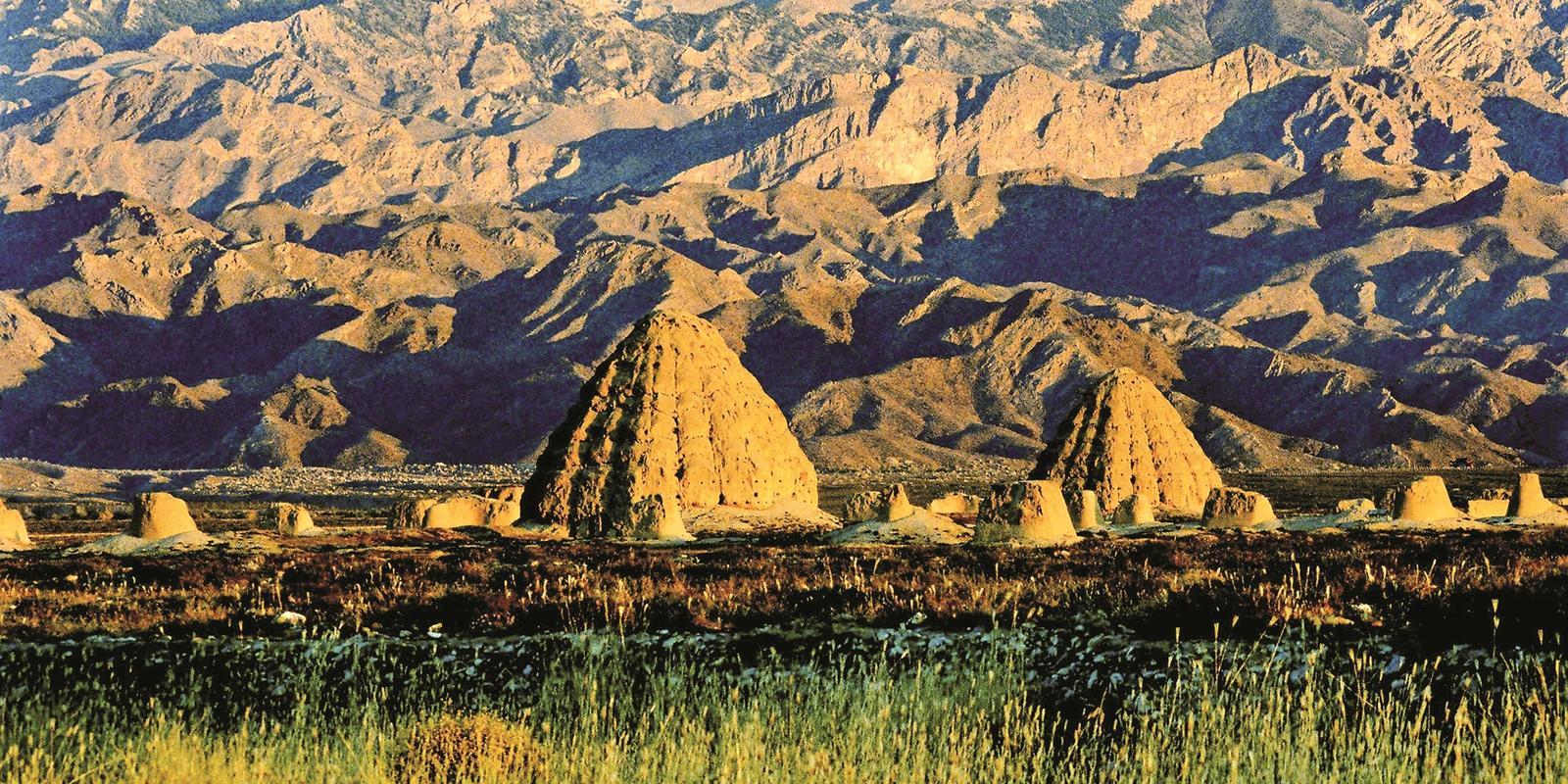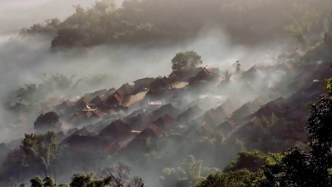
The Paper learned that at the 47th World Heritage Conference held at the UNESCO headquarters at 16:23 Paris local time on July 11, 2025 (22:23 Beijing time on July 11, 2025), as the review of the newly-appointed World Heritage projects was completed, the President of the Conference announced that China's project, the Western Xia Tombs, had successfully passed the review and was successfully included in the World Heritage List, becoming China's 60th World Heritage. This is also the only project submitted by China at this World Heritage Conference.
As one of China's "Top 100 Archaeological Discoveries of the Century", the excavation and discovery of the Western Xia Tombs allow people today to glimpse the historical features of a dynasty that lasted for nearly two hundred years a thousand years ago. It has the universal values of "witnessing a disappearing civilization" and "the integration of diverse cultures", and provides a vivid testimony to the diverse and unified structure of Chinese civilization and the formation and development of a unified multi-ethnic country.

Photos of the Western Xia Tombs at the 47th World Heritage Conference
"There are many ancient tombs at the foot of the Helan Mountains, and they are like scum floating on water. When I met an ancient man on the road, he told me that he was a king or a marquis in the past." This is a poem by Zhu Zhijiong, the Ansai King of the Ming Dynasty, describing the Western Xia Tombs. At the foot of the Helan Mountains, the mysterious giant tombs stand quietly, reflecting the majestic mountains, revealing the grandeur of the Western Xia Tombs in Ningxia.
When the images of the nine giant tombs were projected onto the screen in the review hall of the 47th World Heritage Conference held in Paris, the world was examining not only a group of tombs, but also the echo of a once-vanished dynasty. From the blank in the writings of Yuan Dynasty historians to the coordinates on the global heritage map, the 14-year application process of the Western Xia Tombs for World Heritage status has finally made this "forgotten epic" a contribution of the Chinese nation to human civilization.
Rao Quan, Vice Minister of Culture and Tourism and Director of the State Administration of Cultural Heritage, spoke on behalf of the Chinese government at the World Heritage Conference, thanking all international organizations and contracting states for their recognition and support for the "Western Xia Tombs" project and China's world cultural heritage work. He said that the Chinese government will continue to unswervingly fulfill its obligations under the World Heritage Convention, continue to work hard to ensure that the outstanding value of the Western Xia Tombs is widely disseminated and permanently inherited, further strengthen the overall and systematic protection of cultural and natural heritage, and effectively improve the ability and level of heritage protection. He is willing to share China's experience and cases with countries around the world, provide professional and technical support, and jointly protect the cultural treasures of all mankind.
Wang Changfeng, deputy director of the Yinchuan Xixia Mausoleum District Management Office and a cultural and museum research librarian, said in an interview earlier: "The earliest record of the Xixia Mausoleum was found in the "History of the Song Dynasty: The Biography of the Xia Kingdom", but the "History of the Song Dynasty" did not explain where these emperors' tombs were buried. In the "New Records of Ningxia in the Hongzhi Period", it is recorded: "To the east of Helan Mountain, there are several towering tombs, which are the pseudo-Xia Jiayu's tombs. Its system was modeled after the Song Mausoleum in Gong County (now Gongyi City). Zhu Zhijiong, the Ansai King of the Ming Dynasty, once wrote a poem that vividly described the scene of the high and low scattered tombs of the Xixia Mausoleum Group. In the 1930s, when the German pilot Castel flew over the Helan Mountains, he used the camera he carried with him to "freeze" a strange building at the foot of the mountain - a conical mound, and included it in his book "China Flight". As a part of Chinese civilization, it has been sleeping quietly here for nearly a thousand years. It was not until the 1970s that field investigations and excavations of the Western Xia Tombs were carried out, and archaeologists basically clarified the overall layout of the Western Xia Tombs, the composition of the remains, and other information. Its mysterious veil was gradually unveiled. "
"The Western Xia Tombs are the key to decoding Western Xia society. It consists of 9 imperial tombs and 271 burial tombs, forming the most complete rammed earth cemetery complex in China. The strict hierarchical layout is actually a miniature mirror of the Western Xia Dynasty," said Wang Changfeng.

The 47th World Heritage Conference reviews the Western Xia Tombs.

Western Xia Tombs at the foot of the Helan Mountains Photo provided by the Ningxia Hui Autonomous Region Department of Culture and Tourism (file photo)
China's 60th World Heritage Site is born
It is reported that the 30 projects nominated to be added to the World Heritage List this year include 24 cultural heritage sites, 5 natural heritage sites and 1 natural and cultural dual heritage project.
The official website of the UNESCO World Heritage Committee describes the Xixia Tombs in Ningxia, China as follows: The Xixia Tombs are the largest, highest-level, and best-preserved remains of the Xixia Dynasty (1038-1227) that have survived to this day. The archaeological remains include: 9 imperial tombs, 271 tombs for burials, a large-scale building site of 50,300 square meters (northern building site), 32 flood control engineering sites, and more than 7,000 pieces (sets) of building components, broken steles, and other cultural relics unearthed in the mausoleum area. The Xixia Tombs provide a special testimony to the disappeared Xixia civilization and provide indispensable archaeological support for the formation and development of a unified multi-ethnic country in China.

The Western Xia Mausoleum at the foot of the Helan Mountains (Source: Western Xia Mausoleum Scenic Area Official Website)
Over the past half century, field surveys and archaeological excavations of the Western Xia Tombs have continued, and information on their overall layout and the composition of the remains has become increasingly clear. According to the website of the State Administration of Cultural Heritage, since the investigation and confirmation of the Western Xia Tombs in 1971, the underground palace of the Western Xia Tombs No. 8 (now Mausoleum No. 6), the stele pavilion of the Mausoleum No. 2 (now Mausoleum No. 7), the No. 108 accompanying tomb (now MⅢ-107), the No. 101 accompanying tomb (now MⅣ-001), the east and west stele pavilions of the No. 3 Mausoleum, and the northern end of the building site have been investigated and excavated, gradually clarifying the layout and distribution characteristics of the mausoleum area. Since the 21st century, the cleaning of the ground remains of the No. 3 and No. 6 Mausoleums has more clearly presented the unique cultural features of the Western Xia Tombs.
Wang Changfeng, deputy director of the Yinchuan Xixia Mausoleum District Management Office and a cultural and museum researcher, believes that the glazed pottery components such as Kalavinka (the bird of music) and Capricorn unearthed from Mausoleum No. 3 (presumably Li Yuanhao's Tai Mausoleum) confirm that the offering hall is a Buddhist palace-style building, reflecting "the deep integration of Buddhist elements and imperial authority."
Xixia culture is a relatively unique branch of the ancient culture of the Chinese nation. The Xixia Tombs are the most powerful witness of the disappeared Xixia civilization. The mausoleum ruins and unearthed cultural relics reveal the characteristics of the Xixia Dynasty in terms of social system, religious beliefs, funeral customs, and many cultural and technological aspects. They are witnesses to the long-term exchanges and influences between Xixia civilization and surrounding regimes and ethnic groups. The inclusiveness and unique innovation of Xixia culture displayed in the Xixia Tombs embody the process of diversity and unity of the Chinese nation.
Protection and inheritance and the long road to heritage application
In 1988, the Western Xia Tombs were listed as a national key cultural relic protection unit and a national key scenic spot. In 2006, they were included in the preliminary list of China's national natural and cultural dual heritage. In 2011, the application for the Western Xia Tombs National Archaeological Site Park and World Cultural Heritage was launched. In 2012, the Western Xia Tombs were included in the preliminary list of China's World Cultural Heritage by the State Administration of Cultural Heritage. 2017: It was rated as a "National Archaeological Site Park", and environmental improvement and infrastructure upgrades were accelerated; 2021: It was listed as one of China's "Top 100 Archaeological Discoveries in a Century", and academic support and international publicity went hand in hand. 2025: As China's only application project to sprint for World Heritage, the text highlights its universal value of "witnessing the disappearance of civilization" and "multicultural integration".
Since the systematic archaeological work began in the 1970s, the government of the heritage site has attached great importance to the protection and management of the Western Xia Tombs. In the 1980s, the Western Xia Tombs were successively listed as key cultural relics protection units in Yinchuan and the whole country, and a special protection and management agency was established. The Western Xia Tombs is one of the earliest heritage sites in China to formulate a cultural relics protection plan and implement protection projects. In the 1990s, the Yinchuan Western Xia Tombs District Management Office cooperated with the Dunhuang Academy, which is the leading technology for the protection of earthen sites in arid areas in China, and continued to explore and practice the protection technology of the Western Xia Tombs earthen sites. So far, a set of effective protection engineering measures have been formed.

Western Xia Mausoleum Museum
The application for the Xixia Mausoleum to be listed as a World Heritage Site was launched in November 2011. In 2012, the Xixia Mausoleum was included in the "China World Cultural Heritage Tentative List", which put forward higher requirements for its protection.

Fragmentary stele with Xixia inscriptions
In 2025, the Western Xia Tombs were officially identified as a national World Cultural Heritage project, and a complete nomination document was submitted to the UNESCO World Heritage Center, marking the critical stage of the application. On July 11, 2025, the Western Xia Tombs were included in the World Heritage List, becoming my country's 60th World Heritage.
Witness the Diversity and Integration of Chinese Civilization
The Western Xia was a feudal dynasty established in the early 11th century by the Dangxiang Qiang people. Since Li Yuanhao proclaimed himself emperor and founded the country in Xingqing Prefecture (Yinchuan City) in 1038, it was destroyed by Mongolia in 1227. It existed for 189 years in history and experienced 10 emperors. Its territory "extended to the Yellow River in the east, Yumen in the west, Xiaoguan in the south, and the desert in the north, covering an area of more than 10,000 miles." At its peak, it covered an area of about 830,000 square kilometers, including most of Ningxia and Gansu, western Inner Mongolia, northern Shaanxi, eastern Qinghai, eastern Xinjiang and southern Mongolia. In the early period, it shared equal power with the Northern Song Dynasty and Liao Dynasty, and in the middle and late period, it stood on equal terms with the Southern Song Dynasty and Jin Dynasty. It was described as "one of the three kingdoms in the world, dominating the northwest for two hundred years."
After the fall of the Western Xia, the Yuan Dynasty did not compile the history of the Western Xia. Due to the lack of historical materials, the Western Xia language is mysterious and difficult to decipher, and the history of the Western Xia is complicated and confusing. The Western Xia Mausoleum has become a key to unlocking the mystery of the Western Xia history.
The Western Xia Tombs are a mausoleum site complex with unique architectural forms and important cultural connotations. It is also the first World Cultural Heritage site declared by Ningxia. Archaeological research has found that the Western Xia Tombs largely absorbed and borrowed from the mausoleum system of the Central Plains dynasties. Archaeological experts Han Zhaomin and Li Zhiqing wrote in the "Survey Brief of the Western Xia Tombs in Yinchuan, Ningxia": "From the geographical location of the royal mausoleum area, it is backed by mountains and faces the river, and the terrain is mutually beneficial. This reflects that the selection of the site for the Western Xia royal mausoleum area was deeply influenced by the mountain tomb burial rituals and feng shui of the Tang and Song dynasties."

Cultural relics on display at the Xixia Mausoleum Museum
In terms of layout, the Western Xia Tombs inherited the main features of the Tang and Song imperial tombs and made some innovations: the mausoleum city including the mausoleum gate, corner towers, offering halls, and mausoleum towers, as well as the constituent elements such as the sacred road and tower platforms outside the mausoleum city, and the axial symmetrical layout of "sacred road-mausoleum city" were preserved; the paired platforms in the Northern Song imperial tombs were removed and replaced with stele pavilions, and the stele pavilion system was applied to every imperial mausoleum and some high-level tombs of accompanying burials.

Western Xia Mausoleum Museum
The cultural relics unearthed in the mausoleum vividly reveal the mysterious and splendid history of the Western Xia Dynasty and the process of its interaction and integration with the Central Plains culture. Through archaeological research, archaeologists have discovered that a large number of stone fragments, including those in the Western Xia and Chinese languages, have been unearthed in the ruins of many pavilions in the Western Xia Mausoleum. The coexistence of stone tablets in two languages shows that the cultures of the Dangxiang and Han nationalities both have an important position in the Western Xia Dynasty. The architectural components unearthed in the Western Xia Mausoleum have concentratedly demonstrated the innovations made by the Western Xia Dynasty on the basis of the shapes and materials of the building materials in the Central Plains, and their craftsmanship level is comparable to that of the Central Plains. The stone bases of the stele unearthed in the pavilions of the mausoleums are different from the tortoise-shaped bases commonly seen in the Central Plains culture. They were created by the Western Xia people in the style of the Buddhist stone carving art of the Tang and Song Dynasties. The coins, silk, beads, gold and silver ornaments and other funerary objects unearthed in the mausoleum area have witnessed the active trade and exchange activities during the Western Xia period, revealing the hub characteristics of the Western Xia Dynasty in the cross-regional exchange activities on the "Silk Road" that runs through the Eurasian continent.
Introduction to the Western Xia Mausoleum:
The Western Xia Mausoleums are located at the eastern foot of the Helan Mountains, about five kilometers from east to west and ten kilometers from north to south. Within the area of more than 50 square kilometers, there are nine imperial tombs and more than 200 tombs of princes and nobles. The Western Xia Mausoleums are comparable in size to the Ming Dynasty Thirteen Tombs in Beijing. The ground buildings in the mausoleum are composed of building units such as corner towers, gates, stele pavilions, outer cities, inner cities, offering halls, and tower-shaped mausoleum platforms. The overall layout is a longitudinal rectangle, arranged in a traditional Chinese format with the north-south center line as the axis and striving for left-right symmetry. The Western Xia Mausoleums constitute a unique Western Xia architectural form in my country's mausoleum architecture.

Panoramic view of Mausoleum No. 1 and No. 2 (Source: Official website of Xixia Mausoleum Scenic Area)

Panoramic view of Mausoleum No. 3 (Source: Official website of Xixia Mausoleum Scenic Area)

A distant view of Mausoleum No. 4 (Source: Official website of the Xixia Mausoleum Scenic Area)

A bird's-eye view of Mausoleum No. 6 and Tomb MⅢ-093 (Source: Official website of the Western Xia Mausoleum Scenic Area)
There are 9 imperial tombs in the Western Xia Mausoleum, namely Yuling, Jialing, Tailing, Anling, Xianling, Xianling, Shouling, Zhuangling and Kangling. They face south and are arranged in the order of Zhaomu (the ancient patriarchal system). The left is Zhao and the right is Mu; the father is Zhao and the son is Mu), forming two rows from east to west. There are 254 tombs for burial. There is a three-courtyard building site at the north end, which is the mausoleum town (or ancestral temple). There are brick and tile kiln and lime kiln sites on the eastern edge, which are the kiln workshops in the mausoleum area. The Western Xia Mausoleum not only absorbed the strengths of the imperial mausoleums since the Qin and Han Dynasties, especially the Tang and Song Dynasties, but also was influenced by Buddhist architecture, so that the Han culture, Buddhist culture and Dangxiang ethnic culture are organically combined, forming a unique form of mausoleum architecture in my country.

Panoramic view of Mausoleum No. 7 (from south to north) (Source: Official website of Xixia Mausoleum Scenic Area)

Mausoleum Tower No. 8 (North to South) (Source: Official Website of the Western Xia Mausoleum Scenic Area)

Panoramic view of the No. 9 Mausoleum Tower (from south to north) (Source: Official website of the Western Xia Mausoleum Scenic Area)
Each imperial mausoleum of the Western Xia Tombs is a complete building complex, covering an area of more than 100,000 square meters, facing south and built on flat ground. The tall Quetai stands at the southernmost end of the mausoleum like a majestic gatekeeper. Behind it is the stele pavilion, where stone tablets inscribed in Western Xia and Chinese characters praising the emperor's achievements were once placed. Behind the stele pavilion is the Moon City, and the gate is located in the middle of the south wall. Through the gate, you can enter the Moon City, where stone statues of civil officials and military generals were placed. Some imperial mausoleums also have outer cities, which are closed, horseshoe-shaped, and have outer cities with urns. The basic pattern has been innovated on the basis of the imitation of the Song Dynasty mausoleum.
(Part of the information in this article refers to relevant reports from the State Administration of Cultural Heritage, the official website of the Western Xia Mausoleum Scenic Area, and Xinhua News Agency)


